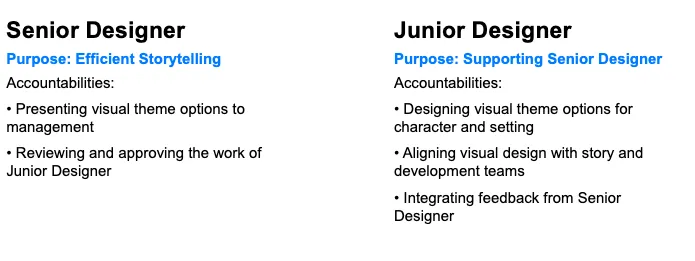Resolving Authority vs Execution When Defining Roles
What if the person with the authority over the work is different than the person actually doing the work?
What if the person with the authority over the work is different than the person actually doing the work?
In Holacracy, or any good self-management practice, it’s important to have clear and distinct roles. Meaning, people actually refer to them when making project requests or, they look up their own role definition when they need to get clear. Note: For more on why it’s important to distinguish roles versus souls here.
The point is to make the expectations of the role clear, while also allowing the role-filler to use their own best judgment within those constraints. But there is a problem; especially if your team or organization is in the process of transitioning into a self-management practice.
That’s because while the traditional management hierarchy often includes instances of the supervisor/supervisee dynamic in which the person who is ultimately responsible for the work is different than the person who is actually executing the work, that dynamic doesn’t translate easily into roles. Because while it may be easy to define the role itself, it’s less clear who you should put in it.
Say, for example, the graphics department in a small video game company is responsible for, “Creating the visual concept for characters, settings, and stories.” That’s a clear accountability we want to capture. But there are two people doing that work; a senior designer with supervisory duties and a junior designer who is actually doing the work. Which person gets assigned to that work (i.e. put into the role)?
The solution is to remember what it means, broadly speaking, to fill a role. Filling a role on a self-managed team means that you are the individual who is simultaneously the person who is responsible for the work, AND the person who is actually doing the work. At least that’s the goal.
So, while the traditional management hierarchy sometimes separates these two, when you’re transitioning into discretely defined self-managed roles, each role, ideally, should BOTH: 1) evoke a sense of a responsible decision-maker, while also defining 2) any ongoing activities that the role should perform.
“The person who sweeps the floor should get to pick the broom.”
Howard Behar
So, if we return to the graphics department dilemma with the senior and junior designer, here’s is what I would suggest: Create two roles and have each describe their own discrete activities/expectations (see image below).

Capturing the distinctions into two different roles not only provides helpful specifics, but is in keeping with the spirit of having self-managed roles. Meaning each role-filler has autonomy to use their own interpretation and their own best judgment.
But of course we don’t want autonomy to the exclusion of alignment. We want freedom, but within defined constraints. So, while it might work perfectly well to just create two roles, if needed, you could further clarify the scope of each role, which we would capture in a purpose in Holacracy practice (see image below).

While this issue is somewhat specific to an organization who is in the process of transitioning from a traditional management hierarchy to a role-based structure, there is a version of this issue which could crop up at any time…
Say, for example, I have an Accounting role, but because I don’t actually know much about accounting, therefore the way I energize that role is to hire an outside accounting firm. In this case, I am responsible for the work, while the external accountant I hired is the person actually doing the work.
In this case, we don’t need two roles because the person doing the actual accounting work isn’t a partner in my organization. Note: Outsourcing your work is common and you can read more here.
And this is a helpful version of this issue because it highlights that, in general, if you had to make a choice between the person with ultimate responsibility and the person who is actually doing the work, the appropriate role-filler is likely the person who has ultimately responsibility for the work.
With that said, if it’s about capturing the work of different people within the same organization, then you don’t need to make that choice. Create two roles and adjust the definition of each accordingly so that even someone in a subordinate position has a clear sense of their role’s authority.
To learn more about self-management, join a community of pioneers and check out our e-courses → Self-Management Accelerator
